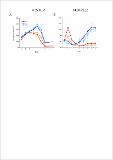Por favor, use este identificador para citar o enlazar a este item:
http://hdl.handle.net/10261/239040COMPARTIR / EXPORTAR:
 SHARE SHARE
 CORE
BASE CORE
BASE
|
|
| Visualizar otros formatos: MARC | Dublin Core | RDF | ORE | MODS | METS | DIDL | DATACITE | |

| Título: | Viral-Mediated Microbe Mortality Modulated by Ocean Acidification and Eutrophication: Consequences for the Carbon Fluxes Through the Microbial Food Web |
Autor: | Malits, Andrea CSIC; Boras, Julia A. CSIC ORCID; Balagué, Vanessa CSIC ORCID ; Calvo, Eva María CSIC ORCID ; Gasol, Josep M. CSIC ORCID ; Marrasé, Cèlia CSIC ORCID ; Pelejero, Carles CSIC ORCID ; Pinhassi, Jarone; Sala, M. Montserrat CSIC ORCID ; Vaqué, Dolors CSIC ORCID | Palabras clave: | Ocean acidification Eutrophication Microbial food web Viral shunt Carbon fluxes |
Fecha de publicación: | abr-2021 | Editor: | Frontiers Media | Citación: | Frontiers in Microbiology 12: 635821 (2021) | Resumen: | Anthropogenic carbon emissions are causing changes in seawater carbonate chemistry including a decline in the pH of the oceans. While its aftermath for calcifying microbes has been widely studied, the effect of ocean acidification (OA) on marine viruses and their microbial hosts is controversial, and even more in combination with another anthropogenic stressor, i.e., human-induced nutrient loads. In this study, two mesocosm acidification experiments with Mediterranean waters from different seasons revealed distinct effects of OA on viruses and viral-mediated prokaryotic mortality depending on the trophic state and the successional stage of the plankton community. In the winter bloom situation, low fluorescence viruses, the most abundant virus-like particle (VLP) subpopulation comprising mostly bacteriophages, were negatively affected by lowered pH with nutrient addition, while the bacterial host abundance was stimulated. High fluorescence viruses, containing cyanophages, were stimulated by OA regardless of the nutrient conditions, while cyanobacteria of the genus Synechococcus were negatively affected by OA. Moreover, the abundance of very high fluorescence viruses infecting small haptophytes tended to be lower under acidification while their putative hosts' abundance was enhanced, suggesting a direct and negative effect of OA on viral–host interactions. In the oligotrophic summer situation, we found a stimulating effect of OA on total viral abundance and the viral populations, suggesting a cascading effect of the elevated pCO2 stimulating autotrophic and heterotrophic production. In winter, viral lysis accounted for 30 ± 16% of the loss of bacterial standing stock per day (VMMBSS) under increased pCO2 compared to 53 ± 35% in the control treatments, without effects of nutrient additions while in summer, OA had no significant effects on VMMBSS (35 ± 20% and 38 ± 5% per day in the OA and control treatments, respectively). We found that phage production and resulting organic carbon release rates significantly reduced under OA in the nutrient replete winter situation, but it was also observed that high nutrient loads lowered the negative effect of OA on viral lysis, suggesting an antagonistic interplay between these two major global ocean stressors in the Anthropocene. In summer, however, viral-mediated carbon release rates were lower and not affected by lowered pH. Eutrophication consistently stimulated viral production regardless of the season or initial conditions. Given the relevant role of viruses for marine carbon cycling and the biological carbon pump, these two anthropogenic stressors may modulate carbon fluxes through their effect on viruses at the base of the pelagic food web in a future global change scenario | Descripción: | 19 pages, 4 figures, 4 tables, supplementary material https://doi.org/10.3389/fmicb.2021.635821.-- The original contributions presented in the study are included in the article/Supplementary Materials, further inquiries can be directed to the corresponding authors | Versión del editor: | https://doi.org/10.3389/fmicb.2021.635821 | URI: | http://hdl.handle.net/10261/239040 | DOI: | 10.3389/fmicb.2021.635821 | E-ISSN: | 1664-302X |
| Aparece en las colecciones: | (ICM) Artículos |
Ficheros en este ítem:
| Fichero | Descripción | Tamaño | Formato | |
|---|---|---|---|---|
| Malits_et_al_2021.pdf | 760,3 kB | Adobe PDF |  Visualizar/Abrir | |
| Malits_et_al_2021_suppl.docx | 55,9 kB | Microsoft Word XML | Visualizar/Abrir | |
| Malits_et_al_2021_suppl_image_1.TIFF | 174,42 kB | TIFF |  Visualizar/Abrir | |
| Malits_et_al_2021_suppl_image_2.TIFF | 322,19 kB | TIFF |  Visualizar/Abrir |
CORE Recommender
PubMed Central
Citations
1
checked on 19-abr-2024
SCOPUSTM
Citations
6
checked on 06-may-2024
WEB OF SCIENCETM
Citations
5
checked on 28-feb-2024
Page view(s)
78
checked on 14-may-2024
Download(s)
123
checked on 14-may-2024

